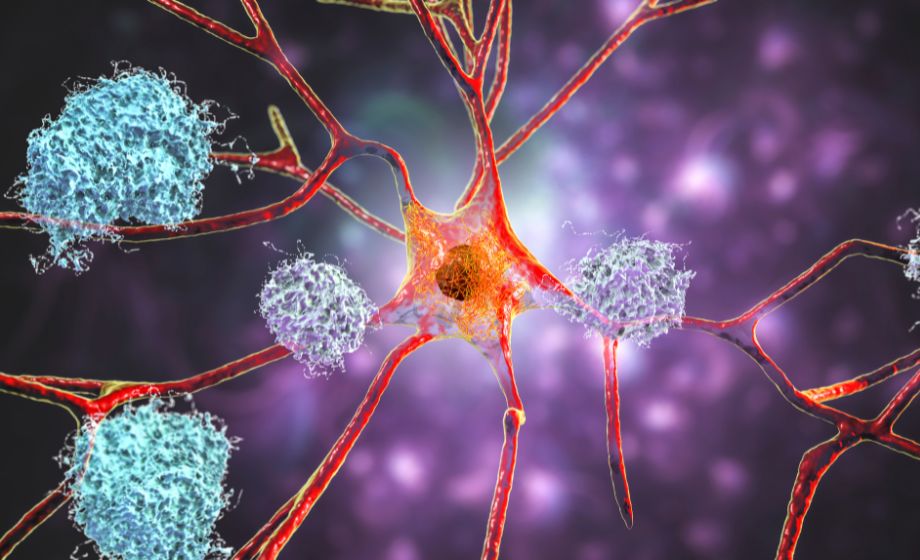Brain-Derived Tau in Blood: the Future of Alzheimer’s Disease Diagnosis?
Blog post by Nina Culum, MSc
Despite the increasing prevalence of Alzheimer’s disease worldwide, a single, non-invasive test for use in clinical practice is still urgently needed. At present, physicians assess the degree of memory or cognitive impairment in patients who may have Alzheimer’s disease, and look for signs of behavior or personality changes [1]. Additionally, pathophysiological hallmarks of Azheimer’s (i.e., amyloid-β, tau, and neurodegeneration) can be detected in cerebrospinal fluid (CSF) or by imaging techniques like positron emission tomography (PET), which can help rule out other possible causes of cognitive impairment [2, 3].
Since these types of tests are invasive and expensive, researchers are turning to blood-based biomarkers to improve Alzheimer’s disease diagnosis in the clinic, particularly at the early stage. Recently published in Brain, Gonzalez-Ortiz et al. report the design and development of a novel blood-based biomarker specific to brain-derived tau, which they validated in five independent clinical cohorts [4]. In this blog post, we dive into the advantages of their novel immunoassay over those that are commercially available, as well as its future implications for Alzheimer’s disease diagnosis.
Given that Alzheimer’s disease is multifactorial and heterogenous, drug development progress is more likely to occur if multiple pathways are considered. Two recent Nature publications have potentially identified medin and PLD3 as new targets for Alzheimer’s disease treatment, which we summarize in this mini-review. READ NOW
Why target brain-derived tau for Alzheimer’s disease diagnosis?
Blood-based total tau primarily originates from peripheral sources (e.g., liver, kidney, heart, pancreas) and poorly correlates with total tau levels in CSF. To address this challenge and improve diagnostic accuracy, the authors designed the TauJ.5H3 monoclonal antibody to selectively bind to brain-derived tau. The authors demonstrated that this antibody can recognize all six tau isoforms that are abundantly expressed in the human central nervous system (CNS) while avoiding those from peripheral tissues. By pairing this antibody with an N-terminal tau-targeting antibody, the authors also developed a novel immunoassay for measuring brain-derived tau, which performed well in both plasma and serum samples.
Does peripheral tau interfere with Alzheimer’s disease diagnosis?
The authors hypothesized that if peripheral tau does not affect brain-derived tau measurements, there should be good correlation between paired CSF and blood samples. Indeed, using their novel immunoassay, the authors found a strong correlation between brain-derived tau levels in paired serum and CSF samples from individuals with Alzheimer’s disease. In contrast, when using a commercially available immunoassay, no correlation was observed between plasma total tau and the same paired samples, suggesting interference from peripheral tau.
Furthermore, plasma total tau measured with the commercial assay was elevated in Alzheimer’s disease CSF samples compared to negative controls, but not in paired serum samples, whereas brain-derived tau levels measured with the novel assay were higher in Alzheimer’s disease samples compared to negative controls in both CSF and paired serum samples. Thus, although both the authors’ novel immunoassay and the current commercial alternative could differentiate between Alzheimer’s disease and controls in CSF samples, only the new brain-derived tau-specific assay could do so in serum. The diagnostic accuracy of serum brain-derived tau was calculated to be 100%, compared to 67% for serum total tau.
Can plasma brain-derived tau differentiate Alzheimer’s disease from other neurodegenerative diseases?
Yes: the plasma brain-derived tau assay could differentiate those with Alzheimer’s disease from those with non-Alzheimer’s disease neurodegeneration with approximately 86% accuracy. In contrast, plasma neurofilament light chain (NfL), the most well-validated biomarker for neurodegeneration, demonstrated no differential diagnostic capability. The authors also found that brain-derived tau in blood is associated with neurodegeneration markers (e.g., CSF total tau, NfL) in Alzheimer’s disease samples, but not in other neurodegenerative diseases.
A review of Alzheimer’s disease pathology, conventional treatments and their limitations, as well as emerging and potential therapies including monoclonal antibodies, metabolic therapies, and stem cell therapies. READ NOW
Is plasma brain-derived tau associated with plaque and tangle pathologies?
Plasma brain-derived tau was elevated in individuals with frequent neuritic plaques compared to sparse plaques, and was correlated with global neuritic plaque counts, but not with cerebral amyloid angiopathy. The authors also share that plasma brain-derived tau correlated with regional measures of plaque pathologies in the hippocampus, superior temporal gyrus, and inferior parietal lobe, while plasma NfL was not correlated with any measures of plaque pathology. Likewise, plasma brain-derived tau correlated with tangle pathology, while plasma NfL did not. The authors also found that brain-derived tau was associated with cognitive performance in Alzheimer’s disease.
What is the value of plasma brain-derived tau in Alzheimer’s disease diagnosis?
Since the antibody used in this assay specifically binds to CNS tau isoforms, it does not capture tau from peripheral sources like the current plasma total tau biomarker. Additionally, while plasma brain-derived tau can detect neurodegeneration in Alzheimer’s disease with high accuracy similarly to NfL, it also demonstrates a novel capability of distinguishing pathologically-confirmed Alzheimer’s disease from other neurodegenerative diseases, unlike NfL.
The authors also note that although plasma phosphorylated tau can differentially detect Alzheimer’s disease, there is a need for separate biomarkers for amyloid, tau, and neurodegeneration. Plasma brain-derived tau herein has demonstrated high potential as a biomarker of Alzheimer’s-specific neurodegeneration, and combining it with phosphorylated tau and even amyloid markers can increase the accuracy of a blood-based Alzeiheimer’s diagnosis.
How soon can we use brain-derived tau to diagnose Alzheimer’s disease in clinical practice?
Although the results presented in this study are promising, many more tests must be performed before this novel biomarker can be used in the clinical setting. For example, the authors plan to explore the characteristics of brain-derived tau in the context of both sporadic and familial Alzheimer’s disease, as well as its associations with neuroimaging biomarkers. The authors will also verify the biomarker’s generalizability in multi-ethnic cohorts from diverse populations. Beyond Alzheimer’s disease, brain-derived tau could help diagnose other diseases and disorders in which CSF total tau is also increased, such as acute traumatic brain injury and Creutzfeldt–Jakob disease.
About the Author
About the Author

Nina Culum graduated from the University of Western Ontario with a Master of Science in physical and analytical chemistry. During her graduate studies, she fabricated plasmonic nanohole arrays to capture extracellular vesicles and detect cancer by surface-enhanced Raman spectroscopy. Prior to attending UWO, Nina completed her Bachelor of Science in chemistry at the University of Waterloo.
References
- Mayo Clinic Staff. Diagnosing Alzheimer’s: how Alzheimer’s is diagnosed [Internet]. Mayo Foundation for Medical Education and Research; 2022 May 07 [cited 2023 Jan 11]. Available from: mayoclinic.org/diseases-conditions/alzheimers-disease/in-depth/alzheimers/art-20048075.
- Teunissen CE, Verberk IMW, Thijssen EH, Vermunt L, Hansson O, Zetterberg H, et al. Blood-based biomarkers for Alzheimer’s disease: towards clinical implementation. Lancet Neurol. 2022;21(1):66-77. DOI: 10.1016/S1474-4422(21)00361-6.
- Zetterberg H, Bendlin BB. Biomarkers for Alzheimer’s disease—preparing for a new era of disease-modifying therapies. Mol Psychiatry. 2021;26:296-308. DOI: 10.1038/s41380-020-0721-9.
- Gonzalez-Ortiz F, Turton M, Kac PR, Smirnov D, Premi E, Ghidoni R, et al. Brain-derived tau: a novel blood-based biomarker for Alzheimer’s disease-type neurodegeneration. Brain. 2022;awac407. DOI: 10.1093/brain/awac407. Online ahead of print.

